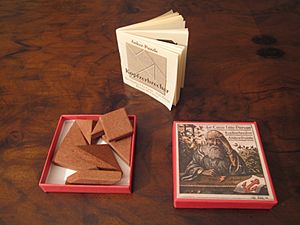Anchor Stone Blocks facts for kids
Anchor Stone Blocks (called Anker-Steinbaukasten in German) are special building toys. They are made from stone-like pieces in Rudolstadt, Germany. These sets let you build miniature buildings, just like real architects!
Contents
What Are Anchor Stones Made Of?
Anchor Stone pieces are made from a mix of quartz sand, chalk, and linseed oil. They are pressed very carefully into molds. This makes sure all the pieces fit together perfectly.
The stones come in three colors. These colors look like the real building materials used in Europe. You can find red, like brick, tan, like limestone, and blue, like slate. Because some pieces are small, these sets are not for children under 3 years old.
The History of Anchor Stones
How Anchor Stones Started
The idea for Anchor Stones came from Friedrich Fröbel. He was the person who created the Kindergarten system for schools. He noticed that children loved playing with blocks that had different shapes.
The very first Anchor Stone blocks were made by Otto Lilienthal and his brother Gustav. They wanted to build a model of a stone building. So, they made tiny blocks from a mix of quartz sand, chalk, and linseed oil. The Lilienthal brothers were great inventors, but they weren't very good at selling their blocks.
The stone blocks didn't become popular until 1880. That's when Friedrich Adolf Richter, a smart businessman, bought the rights to make them. He paid a good amount of money for the idea and the machines. Richter then created many different sets of these stones. They quickly became very popular! By 1883, people had bought 42,000 sets. In 1894, Richter gave them the name Richter's Anchor Stone Building Sets.
Over the years, more than 600 different sets were made. There were also over 1,000 different stone shapes! Friedrich Richter passed away in 1910. This marked the end of the first big time for Anchor Stones.
Stopping and Starting Again
Anchor Stones kept being made through World War I and World War II. But after World War II, Germany was divided into East and West Germany. The factory ended up in East Germany. In 1953, the government took over the company. Then, in 1963, they stopped making the blocks completely. Other toy companies in East Germany used the "Anker" name, but they didn't make the stone building sets.
Even though production stopped, old Anchor Stone sets stayed very popular around the world. In 1979, a group called the Club van Ankervrienden ("Club of Anchor Friends") started in the Netherlands. At first, only people from the Netherlands could join. But after 1983, people from other countries could join too. As of August 2025, the club has about 230 members.
With help from the Club of Anchor Friends, the state of Thuringia, and the European Union, a person named Georg Plenge was able to bring the company back. The factory in Rudolstadt started making blocks again on September 15, 1994. New sets were sold to Club members in October 1994.
Anchor Stones Today
The new factory now makes and sells all 15 sets from the main Anchor series. They also make special sets that let you build famous landmarks. These include the Michaelis Basilica in Hildesheim and the Brandenburg Gate. You can find them easily in Germany, even in big stores like KaDeWe in Berlin. You can also buy them online.
In 2012, a new series of sets for younger children was introduced. It's called Die neue Steinzeit ("the new Stone Age"). These sets can be a bit expensive, but they are very high quality. Old sets are still just as fun to play with today as they were when they were first made. New sets are made exactly like the old ones, so you can easily mix and match them. Besides building sets, Anchor also uses its special stone formula to make simple flat puzzles, like tangrams.
Cultural Impact of Anchor Stones
Many famous scientists, engineers, and designers played with Anchor blocks. These include people like Max Born, J. Robert Oppenheimer, Albert Einstein, Ivan Sutherland, and Walter Gropius. Playing with these blocks helped them become more creative.
Anchor blocks have even been shown in famous museums, like the Louvre and the Deutsches Museum. They also appear in movies and books. For example, they are in Jan Švankmajer's fantasy film Neco z Alenky. In that movie, they are used to build the White Rabbit's home. They also help with a part of the story in the book The Diamond in the Window, by Jane Langton.


